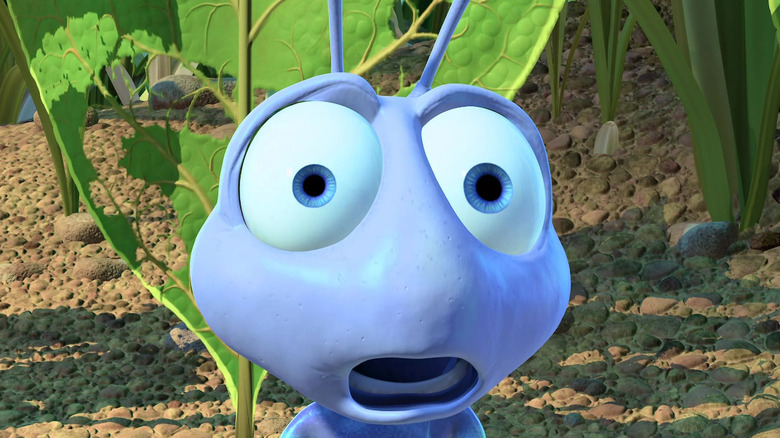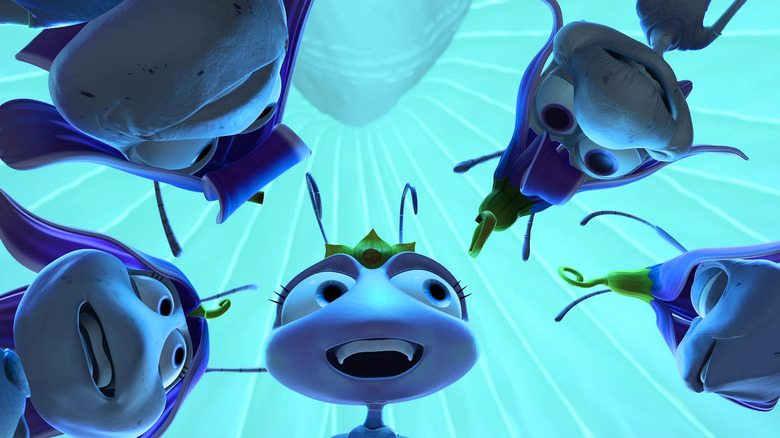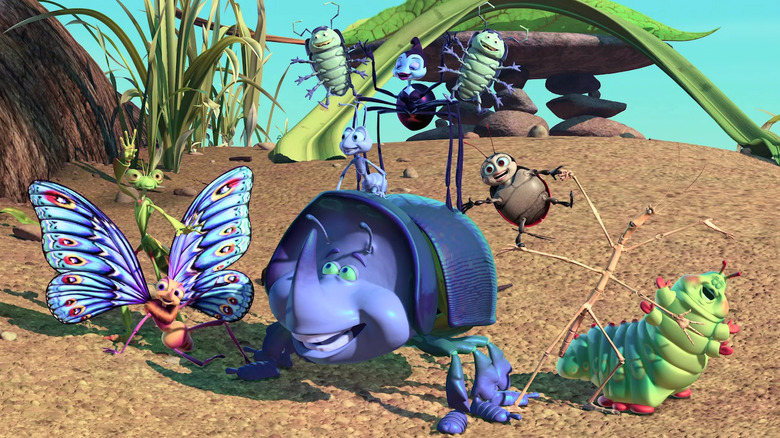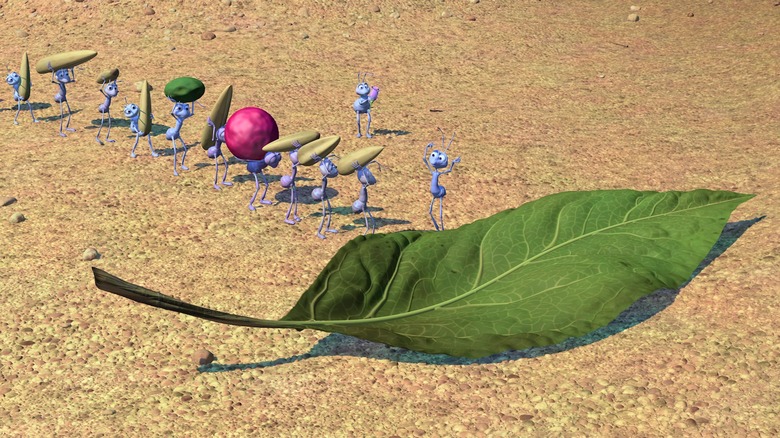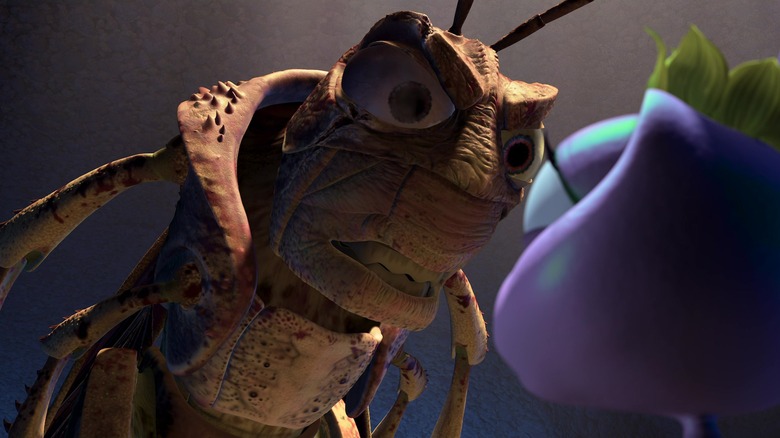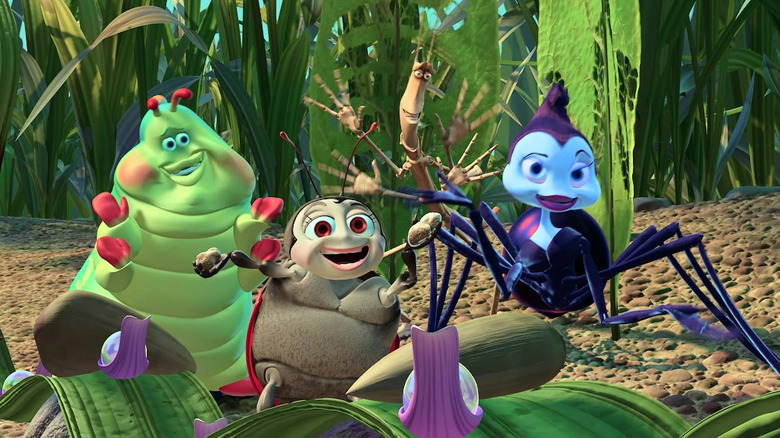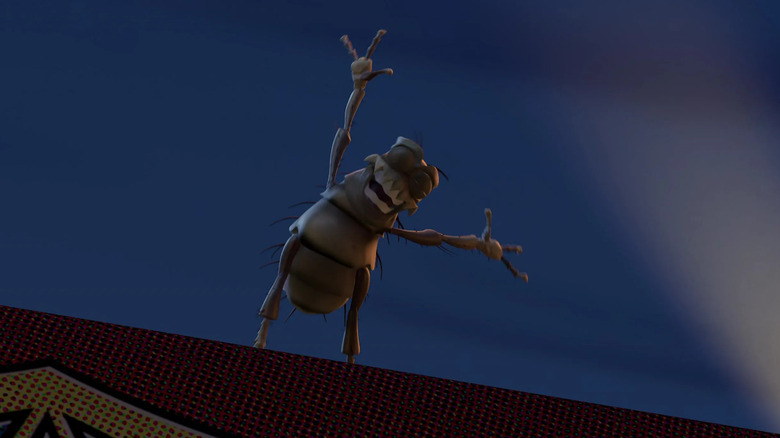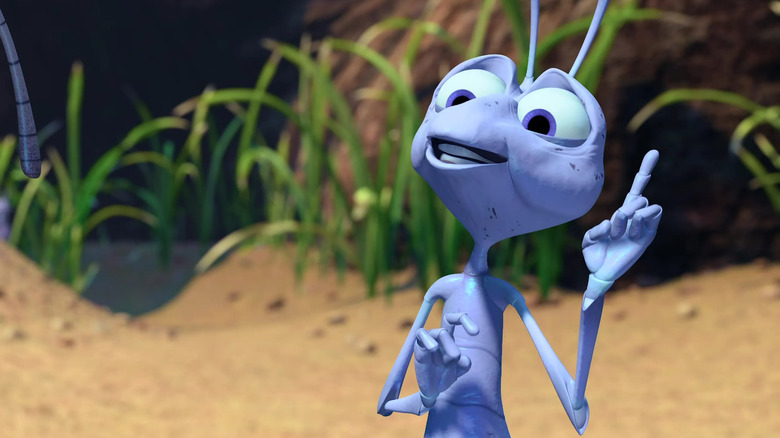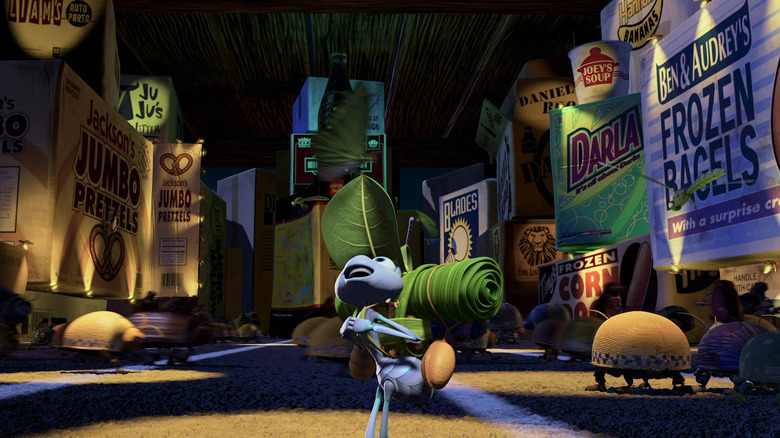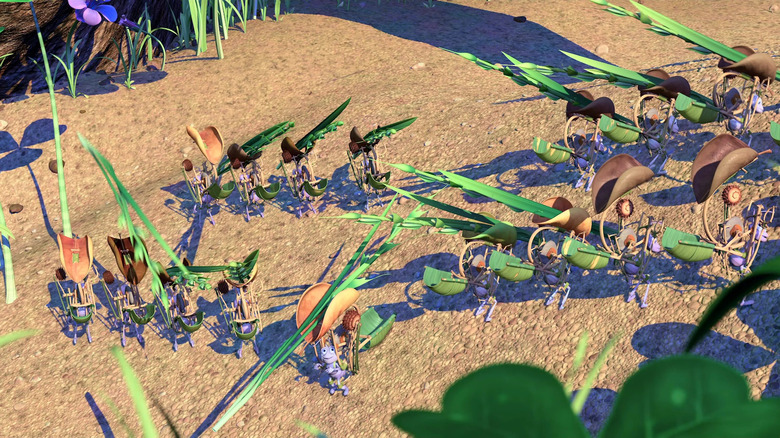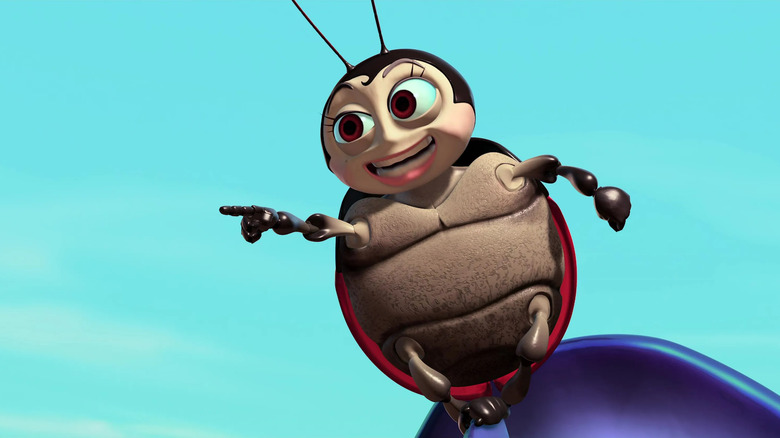Things Only Adults Notice In A Bug's Life
Pixar Animation Studios is known for making computer-animated films that can be enjoyed by children and adults alike. Some of that means their stories have a broad appeal, relatable to the viewer no matter their age. Other times that means throwing in-jokes or plot points that simply go over the heads of younger audience members. The filmmakers are clever about it, though. They can't just put a dirty joke in the script. That would be inappropriate for kids. Instead, they layer the material in a way that makes sense on the surface to those who don't get the subtext, and mean something more for those who do. In other instances, moments in a Pixar film aren't necessarily jokes, but perhaps aged poorly or are indicative of more adult themes that older viewers pick up on.
"A Bug's Life" was Pixar's second film, debuting in 1998. Following Pixar's first movie, "Toy Story," it had big shoes to fill. While it may not have endured such a lasting legacy as its predecessor, it has merit on its own, and certainly includes some things that its children viewers don't get. Here are things only adults notice in "A Bug's Life."
All hail the queen
Princess Atta in "A Bug's Life" follows a long line of established Disney princesses. While she's not acknowledged as part of the official "capital-P" Princess franchise, Atta belongs to an animated tradition that included before her the likes of Snow White, Cinderella, Jasmine, Mulan, and others. Kids who live and breathe Disney movies might simply think Atta's royal status is par for the course, the norm for an animated movie's female lead. While those kids wouldn't be wrong, adults can acknowledge the double entendre of Atta training to be a queen ant. It fits within the real-life entomology of an ant colony.
Most ant colonies have a queen ant, whose responsibility, according to home insect treatment company Terro, is to create a new colony and lay eggs. If Pixar were to follow the science verbatim, this wouldn't mean Atta replacing her mother as the leader of Ant Island. It would instead mean Atta leaving home to begin a colony of her own. Nuances aside, the presence of a queen ant figure in "A Bug's Life" presents a fun learning opportunity for adults to educate child viewers.
The cast is a who's who of '90s sitcom superstardom
Movies can sometimes feel like time capsules of the era in which they released. Tech that seemed revolutionary at the time might seem archaic in contrast to modern advancements. Pop-culture references or the inclusion of slang might have been trendy back then, but now doesn't land without context. Or, as with "A Bug's Life," the cast is a major throwback to some of the most popular shows on television at the time.
"A Bug's Life" debuted in 1998, and that's reflected by a voice cast featuring many actors who starred in hit network sitcoms at the time. Julia Louis-Dreyfus voices Princess Atta, and in 1998 had just finished her eight-year run on "Seinfeld." Brad Garrett plays Dim the beetle. He was in the middle of his tenure as Robert, Ray's brother on "Everybody Loves Raymond." David Hyde Pierce voices Slim the stick bug, and was known for his role as Niles on "Frasier." All three of these shows were iconic sitcoms of the '90s, and having these talents present in "A Bug's Life" was some major star power to not only draw audiences to the theater, but let them know they'd be laughing once they got there. Today, they remind us of some classic comedies of yore.
The twig of '93
If you live in an area prone to extreme weather, like snowstorms, hurricanes, tornadoes, earthquakes, or any kind of natural disaster, you might have a memory of one year when things got really bad. The storm or incident might have even been so infamous that it just came to be known as THE defining act of nature for your community from that year. Any mention of it going forward, and people know what you're talking about just by mentioning the type of event and the year.
In "A Bug's Life," a leaf falls from a nearby tree and blocks the assembly line of ants carrying food. To you and me, it's just a leaf. To an ant, it's cause for all-out panic. An elder ant soon arrives to quell the chaos and redirect the path around the leaf. As he calms the others down, he assures them, "This is nothing compared to the twig of '93." While not necessarily an "adult" joke, its vernacular is more mature than other gags in the script and recalls a disastrous moment in Ant Island history that adult viewers probably picture better than kids. We may not know exactly what happened with this twig in question, but if it's enough to earn its own place in history, it had to have been quite the episode.
Ant Island is located in a dried-up riverbed
Pixar is meticulous in the detail of its sets. The ants' home is surrounded by dry ground. While they refer to it as "Ant Island" — which, by their scale as tiny ants, it certainly seems to be — the area is actually little more than a patch of grass with a tree on it. The immediate area around this elevated haven appears to be a dried-up riverbed. This is no secret. An entire chase sequence with a bird takes place within the cracks of the dry ground (which, to the bugs, seem like canyons). Keen-eyed viewers will notice, though, that at the film's conclusion, water flows around Ant Island.
This suggests a few things. Maybe the area is part of a seasonal ecosystem, and this ebb and flow of water happens every year. Maybe the river had always been dry, and something offscreen related to a new invention of Flik's allowed water to flow through once again. Whatever the case, it's a nice metaphor for restoration of the ants' community that's easy to go unnoticed.
Hopper is... Kevin Spacey?
Sometimes when watching an animated movie, you recognize the voice of a character but just can't place it. You know you've heard that voice before, but who is it? You just can't place the face. Then it hits you. Ohhhh! Oh? Oh. Yes, that's right, the voice of Hopper the, uh, grasshopper in "A Bug's Life" is none other than Kevin Spacey. Having this realization while watching the movie today naturally leads to some unpleasantness for adults.
In 2017, nearly 20 years after "A Bug's Life" debuted, multiple people accused Spacey of sexual assault. Spacey's entire filmography didn't age well as such, including (and perhaps especially) "A Bug's Life." As one of the relatively obscure titles in the Pixar library, at least in comparison to its mega-hit siblings like "Toy Story" or "Finding Nemo," it may come as a surprise to many viewers that Spacey is in the film, or rather has always been in the film, and you never noticed.
It's worth noting that in the 3D film "It's Tough To Be A Bug," featuring characters from "A Bug's Life" and created for Disney theme parks, Hopper is voiced by Pixar director Andrew Stanton. Any chance he might wanna re-dub the main movie?
Things real bugs do
Adults paying close attention to "A Bug's Life" may notice that parts of the movie are based on real life. No, ants can't make their own seed-harvesting mechanical inventions (yet..), but quick moments throughout the script suggest parts of the characters' lives that are accurate to their individual species.
When the grasshoppers interrogate the anthill, Hopper creepily feels his antennae all over Princess Atta's head and remarks, "You don't smell like the queen." In real life, grasshoppers can actually use their antennae to smell. Later, Rosie, the black widow spider mentions she's had 12 husbands. Given the fact that male spiders die after mating, this is quite a promiscuous reveal for the otherwise pretty reserved character. Elsewhere, an announcement to the colony meant to mimic the common phrase "children of all ages" instead changes the words to "larvae of all stages." A larva is an early development stage of many animals. Speaking of larvae, an elderly ant remarks, "We've harvested the same way since I was a pupa," referencing the pupa, or metamorphosis, stage of an insect's life (kind of like bug puberty).
P.T. Flea and his circus of inside references
The fearless leader of the circus bugs is P.T. Flea, who's practically the living embodiment of a round of trivia. Some details most adults might pick up on. Others require a more niche specialty of knowledge.
For starters, his name references P.T. Barnum — famed circus businessman, namesake of Ringling Bros. and Barnum & Bailey Circus, and inspiration for the movie "The Greatest Showman." Since "A Bug's Life" is about, you know, bugs, the film showcases some creative solutions for human-like activities adjusted to a bug's scale. One of these is the circus train. Rather than traveling in an actual locomotive, P.T. leads his crew in a box of Casey Jr. Cookies pulled by millipedes. This is a callback to Casey Jr., the sentient train from "Dumbo" who leads the circus animals' traveling caravan. P.T.'s box of cookies has a label saying the long-gone cookies once inside the box were made by J. Grant Bakery. There's no such thing in real life. Rather, this references the late Joe Grant, a legendary Disney story artist. Grant initially worked with Disney toward the beginnings of the studio, contributing to Mickey Mouse cartoons and co-writing, you guessed it, 1941's "Dumbo." Grant returned to Disney in 1989 and passed away in 2005.
Ant Island has a history of mature theater
One throw-away line in the script for "A Bug's Life" contains a detail that hints at Ant Island having quite a colorful background when it comes to the arts. When the circus bugs arrive and the schoolchildren prepare a skit in their honor, an ant introduces Mr. Soil, the ant schoolteacher. She mentions Mr. Soil is also the island's resident thespian, and played the lead in last season's performance of "Picnic."
Further reading about "Picnic" suggests quite the adult story for little old Ant Island and modest Mr. Soil. Of "Picnic," Playbill provides the following synopsis: "A sexy drifter shakes up a Kansas town, particularly its female inhabitants, including a beautiful young girl who yearns for a more exciting life, her plain and bookish sister, and a moralistic but sexually frustrated schoolteacher." Say what? We need answers! In an alternate timeline, maybe there's an R-rated "Bug's Life" prequel series on Disney+ starring Mr. Soil. Until we discover the multiverse, our imaginations are left to wonder about whatever the heck went down during THAT play season.
The city is a bug's version of New York
One of the more obvious catches in "A Bug's Life" is the city Flik travels to. A contrast to the sleepy, removed, countryside setting of Ant Island, the city mimics the big apple, but shrunk to a bug's size. One area clearly resembles Times Square. Instead of skyscrapers, though, the buildings are just boxes of leftover food, seemingly indicating entire restaurant establishments serving whatever food the box advertises. Neon and flashing lights are merely the work of lightning bugs turning their glow on and off. And yes, the bug world even has Broadway's "Lion King" musical, somehow.
While some kids might recognize the New York homages, hopefully most of them won't understand the bit with the mosquito Flik encounters in the bar. The mosquito asks the bartender to bring him a bloody Mary, "O-positive." The bartender delivers him a literal drop of blood, which the mosquito sucks into his body happily.
Is the story a metaphor about computer animation?
As with many Pixar movies, "A Bug's Life" challenges its audience to walk away with a renewed perspective about a topic beneath the surface of its story. In this case, beyond a tale of talking ants and circus bugs is a message about embracing change, no matter how weird it may seem at first. Ant Island is stuck in its ways and doesn't see the value in Flik's innovative ways of thinking, dismissing his ideas as unhelpful rather than productive. When they stop to listen to him, though, they realize that even though Flik's technology is very different from what they're used to, it has the potential to usher in an exciting new era of harvesting.
It's easy to imagine this as a rally cry for Pixar, an early pioneer of computer animation, during a time when traditional animation was still dominant. "A Bug's Life" debuted in 1998 and was only Pixar's second film. Computer animation being used to create feature-length films was only three years old. It was still a hypothesis, of sorts, and far from the industry standard. Purists could still point to traditional animation as the way things had always been done. With certainly no offense to the beautiful artistry that was and is hand-drawn animation, Pixar was changing filmmaking forever for those who were paying attention.
The ladybug is misgendered the entire movie
Denis Leary voices Francis, the ladybug character who spends nearly every scene he's in getting mistaken for a female. The entire purpose of the character, at first, seems to be to subvert what audiences might traditionally expect from an anthropomorphised ladybug. You think all ladybugs are girls? They're not! Here's a guy ladybug, defying your expectations and teaching a valuable lesson in accepting everyone for who they are. Awesome! No problem there. Things quickly take a turn, and never correct their course, when Francis' gender becomes a recurring joke. No matter how many times he corrects others, nearly everyone refers to him incorrectly as a girl.
Flies make fun of Francis. A group of ant children refer to him as their "denmother" and call him "ma'am." Adults and kids alike talk about him using female pronouns. These things are played for laughs in the movie, but come across as insensitive and set a poor example given the problem of misgendering in the real world. It's a cringe arc that hopefully wouldn't be portrayed the same way if "A Bug's Life" was made today.
Randy Newman gave his all for an underrated score
As the end credits roll on "A Bug's Life" and Randy Newman begins to sing the original song he wrote for the film, "The Time of Your Life," kids may recognize his voice as the guy who sings the "Toy Story" song. And they'd be right, with Newman having also, of course, sung the iconic "You've Got a Friend in Me." Throughout the duration of "A Bug's Life," though, adults may pick up on qualities signature to Newman's style that give away his composing the whole score for the movie. It's just as strong as any of his other work, but somewhat forgotten among the obscurity of the film itself.
The main orchestral theme, which accompanies Pixar's sweeping vistas in the landscape shots and emotional moments in the film, is beautiful and poetic. The bouncy tune that plays as Flik arrives wide-eyed in the big city is catchy and toe-tappable. Newman would go on to compose plenty of other scores for both Pixar and Disney Animation, but "A Bug's Life" remains arguably his most underrated, if only because of its lack of exposure among the often-repeated melodies from other franchises.
